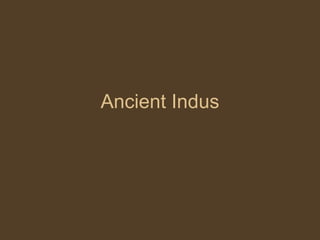Ancient Indus
- 2. Chronological Context 2500 BCE: Harappans settle in the Indus. 2300 BCE: Cultural exchange between Indus and Mesopotamia. 1500 BCE: Marked decline in civilization. 1200 BCE: Aryans take over the Indus Valley.
- 3. Geography 1,000 miles from Himalayas to the Indian Ocean (2x the size of Mesopotamia). Indus and monsoons unstable.
- 4. Economic Organization Agriculture: Barley, wheat, peas, melon, dates. Fishing and domesticaetd animals. Cotton: Dyes. Cloth. Building: Kilns, mud, bricks, and mounds. Granary/Trade.
- 5. Political Organization Planned Cities: Harappa and Mohenjo-Daro – twin capitals? Grids, right angles, and blocks. Structures: 2 stories. Courtyard. No windows! Plumbing. Citadel.
- 6. Social/Cultural Organization Religion: Great Bath? Unable to decipher writing. Polytheistic and female gods? Royalty? Lapus lazuli. Weapons – stone, bronze, and copper. Soapstone seals: Necklazes and bracelets with names, titles, trades?
- 7. Collapse? Natural resources? No trees? Flooding and wind. Invasions? Unburied skeletons with injuries.






